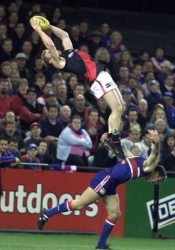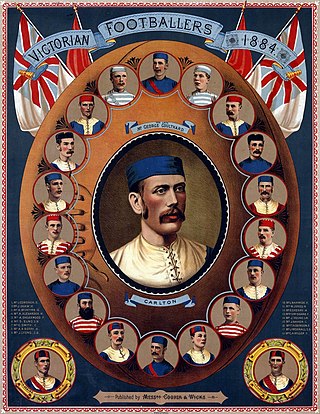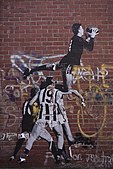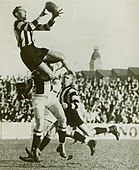
John Douglas Coleman was an Australian rules footballer who played for and coached the Essendon Football Club in the Victorian Football League (VFL).

The 1898 VFL season was the second season of the Victorian Football League (VFL), the highest level senior Australian rules football competition in Victoria. The season featured eight clubs, ran from 14 May until 24 September, and comprised a 14-game home-and-away season followed by a finals series featuring all eight clubs.

The 1904 VFL season was the eighth season of the Victorian Football League (VFL), the highest level senior Australian rules football competition in Victoria. The season featured eight clubs, ran from 7 May until 17 September, and comprised a 17-game home-and-away season followed by a finals series featuring the top four clubs.

A mark in Australian rules football is the catch of a kicked ball which earns the catching player a free kick. The catch must be cleanly taken, or deemed by the umpire to have involved control of the ball for sufficient time. A tipped ball, or one that has touched the ground cannot be marked. Since 2002, in most Australian competitions, the minimum distance for a mark is 15 metres.

The annual Australian Football League Mark of the Year competition is a sporting award that celebrates each season's best mark. A mark is the action of a player cleanly catching a kicked ball that has travelled more than 15 metres (49 ft) without the ball hitting the ground or being touched by another player.
Oleksandr "Alex" Jesaulenko is a former Australian rules footballer and who played for the Carlton Football Club and the St Kilda Football Club in the Victorian Football League (VFL). He also served as a coach at both clubs.

Leslie Roy Foote was an Australian rules footballer in the Victorian Football League.

Dale Robert Jordan “Daisy” Thomas is a former professional Australian rules footballer who played for the Collingwood Football Club and Carlton Football Club in the Australian Football League (AFL). Thomas was a priority pick in 2005 where he then played with the Collingwood Football Club from 2006 to 2013 before transferring to the Blues in 2014.
Shaun Smith is a former Australian rules footballer in the VFL/AFL.

Gary Moorcroft is a former Australian rules football player for Essendon and Melbourne in the Australian Football League (AFL).
The Alex Jesaulenko Medal refers to three unrelated medals in Australian rules football, all named in honour of Alex Jesaulenko, a legend in the Australian Football Hall of Fame. The medals are currently awarded annually to the best player in the grand final of the AFL Canberra league and to the winner of the Mark of the Year in the Australian Football League. In the 1990s a medal of the same name was awarded to the best player for The Allies representative team in State Of Origin football.

Australian rules football has had a significant impact on popular culture in its native Australia, capturing the imagination of Australian film, art, music, television and literature.
The 1981 VFL season was the 85th season of the Victorian Football League (VFL), the highest level senior Australian rules football competition in Victoria. The season featured twelve clubs, ran from 28 March until 26 September, and comprised a 22-game home-and-away season followed by a finals series featuring the top five clubs.
The 1972 VFL season was the 76th season of the Victorian Football League (VFL), the highest level senior Australian rules football competition in Victoria. The season featured twelve clubs, ran from 1 April until 7 October, and comprised a 22-game home-and-away season followed by a finals series featuring the top five clubs – an increase from the four clubs which had contested the finals in previous years.
The 1970 VFL Grand Final was an Australian rules football game contested between the Carlton Football Club and Collingwood Football Club, held at the Melbourne Cricket Ground (MCG) on 26 September 1970. It was the 73rd annual Grand Final of the Victorian Football League, staged to determine the premiers for the 1970 VFL season. The match was won by Carlton by a margin of 10 points, marking that club's 10th premiership victory.
The 1984 VFL Grand Final was an Australian rules football game contested between the Essendon Football Club and Hawthorn Football Club, held at the Melbourne Cricket Ground in Melbourne on 29 September 1984. It was the 88th annual grand final of the Victorian Football League, staged to determine the premiers for the 1984 VFL season. The match, attended by 92,685 spectators, was won by Essendon by a margin of 24 points, marking that club's 13th premiership victory.
Graeme "Jerker" Jenkin is a former Australian rules footballer who played with Collingwood and Essendon in the VFL during the 1960s and 1970s.

The 1946 VFL Grand Final was an Australian rules football game contested between the Essendon Football Club and Melbourne Football Club, held at the Melbourne Cricket Ground on 5 October 1946. It was the 48th annual Grand Final of the Victorian Football League, staged to determine the premiers for the 1946 VFL season. The match was attended by 73,743 spectators.
The AFL Australian Football League is the top professional Australian rules football league in the world. The league consists of eighteen teams: nine based in the city of Melbourne, one from regional Victoria, and eight based in other Australian states. The reason for this unbalanced geographic distribution lies in the history of the league, which was based solely within Victoria from the time it was established in 1897, until the time the league expanded through the addition of clubs from interstate to the existing teams starting in the 1980s; until this expansion, the league was known as the VFL (Victorian Football League).

Mitchell Hannan is a professional Australian rules footballer playing for the Western Bulldogs in the Australian Football League (AFL), having been initially drafted to the Melbourne Football Club. A forward, 1.90 metres tall and weighing 87 kilograms (192 lb), Hannan has the ability to play as a forward and in the midfield. After failing to play in the TAC Cup as a junior, he joined the St Bernard's Football Club in the Victorian Amateur Football Association (VAFA) where he won a premiership and the best on ground in the 2015 VAFA Grand Final. The next year, he played with Footscray in the Victorian Football League (VFL) where he won his second premiership in as many years. His performances in the VAFA and VFL saw him recruited by the Melbourne Football Club in the 2016 AFL draft and he made his debut in the opening round of the 2017 season.























